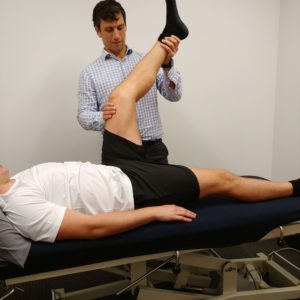I have a patient every week telling me they have tight hamstrings. The implication being that a patient cannot reach their toes. This is claimed to be the reason for many injuries including low back pain, ankle sprain, achilles tendon injury and of course feeling tight in the hamstrings!
But how do we define what a tight hamstring is? Why do they get tight? And is it truly the hamstring muscle that is tight?
 Lets start by looking at the test for hamstring length. Most people use the ability to reach down and touch their toes as a basic measure. We as Physio’s use a number of tests to determine your muscle length. A routine test in a Physio consult is the straight leg raise. But how do we know that these common activities are isolating the hamstrings alone? Well, most of them aren’t.
Lets start by looking at the test for hamstring length. Most people use the ability to reach down and touch their toes as a basic measure. We as Physio’s use a number of tests to determine your muscle length. A routine test in a Physio consult is the straight leg raise. But how do we know that these common activities are isolating the hamstrings alone? Well, most of them aren’t.
The hamstrings are the three muscles that are in the back of the thigh. Tightness in the hamstring can be attributed to a number of things. The muscle actually being shortened where the fibres aren’t long enough along the length of the muscle causing restriction in movement. Weakness in the muscle can cause the muscle to tighten up and feel stiff. An exercised muscle will also hold extra stiffness, or muscle tone therefore not allowing extra movement. And here is my favourite reason for the hamstrings to be tight – it is not the hamstring at all!
So what else could it be? There are a few more structures that can give the impression that you have tight hamstrings. One of these structures are the nerves in the back of the leg. The Sciatic nerve, for example, runs from the lower back down the length of the back of the leg towards the foot and is placed on stretch in forward bending activities. Like many other body tissues it adapts depending on your lifestyle.
Use it or loose it.
As is the case with sedentary lifestyles, our seated posture means we keep some structure in a shortened position (think of flexible tissue not being flexed and utilised for its intended purpose). Over time our body responds to this, reabsorbs the tissue that is above our requirements, and lays down new tissue which reflects our current physical demands. If muscle, tendon or nerve tissue wasn’t stretched very often then this structure would be remodelled to a structure that doesn’t allow too much stretch, a negative adaptation. This can be one very common reason we see more people these days with what they feel are tight hamstrings, but really the tightness felt stems from nerve or neural tightness.
If you are concerned that your hamstrings or other structures are feeling overly tight or causing you harm come in and see one of our experienced clinicians at Bend + Mend in Sydney’s CBD to assess, diagnose and treat the underlying issue.





